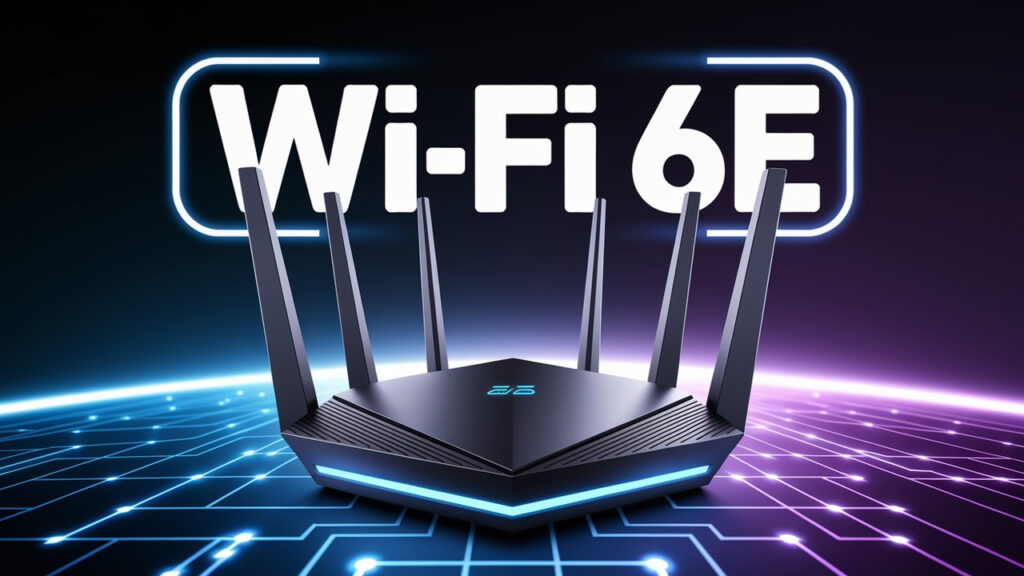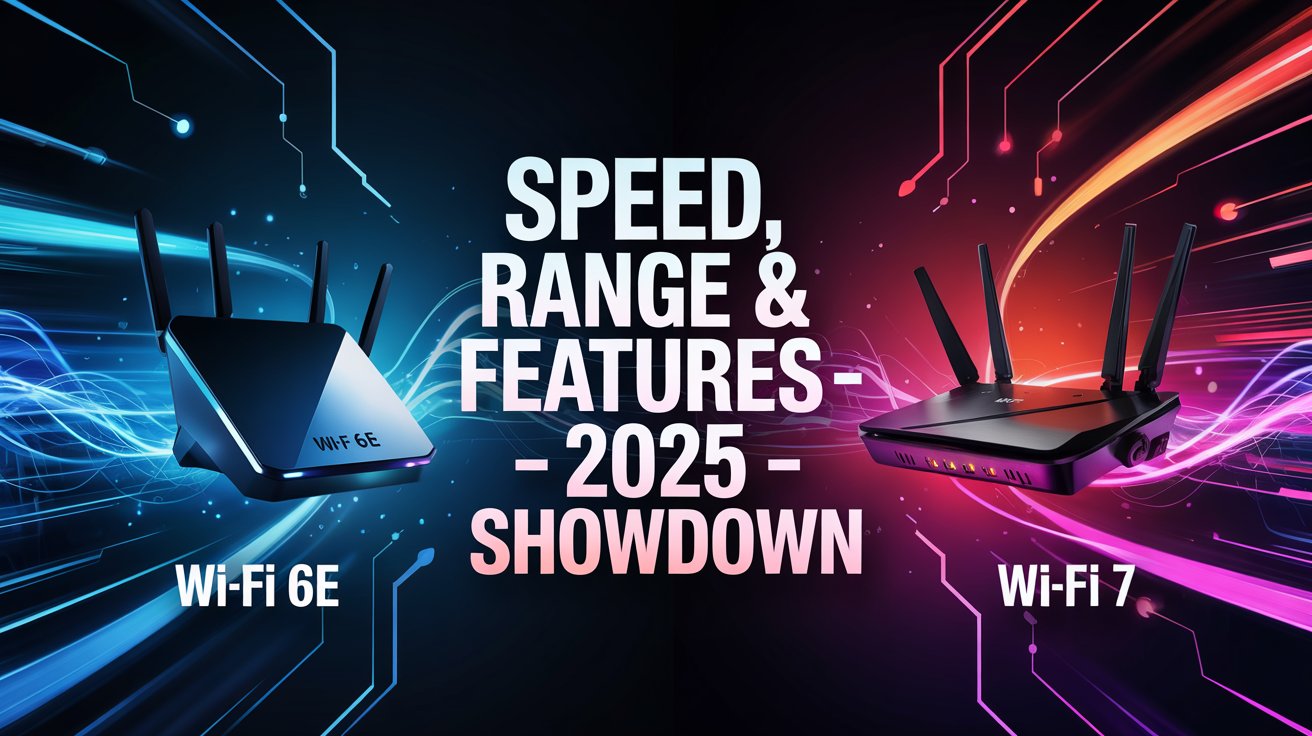Table of Contents
With the rapid advancements in wireless technology, the debate of Wi-Fi 6E vs Wi-Fi 7 has gained momentum in 2025. As we increasingly rely on high-speed internet for gaming, streaming, remote work, and smart devices, it’s crucial to understand the differences between these two cutting-edge technologies. In this comprehensive guide, we’ll compare their speed, range, features, and device compatibility to help you make the right upgrade choice.
📶 What is Wi-Fi 6E?
Wi-Fi 6E is an extension of Wi-Fi 6, officially known as 802.11ax, but it adds support for the 6 GHz band in addition to the traditional 2.4 GHz and 5 GHz bands. The “E” stands for Extended, referring to the expansion into the 6 GHz spectrum, which offers more bandwidth, less interference, and improved performance for modern devices.

Key Features of Wi-Fi 6E:
- Access to 14 additional 80 MHz channels and 7 additional 160 MHz channels
- Reduced network congestion
- Ideal for AR/VR, 4K/8K streaming, and low-latency gaming
- Backward compatible with Wi-Fi 6 and earlier
- Enhanced battery efficiency with Target Wake Time (TWT)
- Better handling of multiple devices using OFDMA (Orthogonal Frequency-Division Multiple Access)
🚀 What is Wi-Fi 7?
Wi-Fi 7, also known as 802.11be Extremely High Throughput (EHT), is the next evolution in wireless connectivity. It builds on the foundation of Wi-Fi 6E and introduces groundbreaking speed and efficiency upgrades, making it the most powerful Wi-Fi standard to date.

Key Features of Wi-Fi 7:
- Up to 46 Gbps theoretical speed (compared to Wi-Fi 6E’s 9.6 Gbps)
- 320 MHz channel bandwidth (double that of Wi-Fi 6E)
- Multi-Link Operation (MLO) for simultaneous multi-band communication
- 16 spatial streams (vs 8 in Wi-Fi 6E)
- Enhanced QoS (Quality of Service) for real-time applications
- Preamble Puncturing for using interrupted channels more efficiently
- CMU-MIMO (Coordinated Multi-User Multiple Input Multiple Output) for handling multiple users simultaneously with high precision
📊 Wi-Fi 6E vs Wi-Fi 7: Feature Comparison
| Feature | Wi-Fi 6E | Wi-Fi 7 |
|---|---|---|
| Spectrum Bands | 2.4 GHz, 5 GHz, 6 GHz | 2.4 GHz, 5 GHz, 6 GHz |
| Maximum Speed | Up to 9.6 Gbps | Up to 46 Gbps |
| Channel Bandwidth | Up to 160 MHz | Up to 320 MHz |
| Spatial Streams | Up to 8 | Up to 16 |
| Multi-Link Operation (MLO) | ❌ | ✅ |
| Latency | Low | Extremely Low |
| Power Efficiency | Good | Better |
| Network Capacity | High | Very High |
| Backward Compatibility | Yes | Yes |
⚡ Speed & Performance
In the Wi-Fi 6E vs Wi-Fi 7 battle, speed is a major differentiator. Wi-Fi 7 significantly increases maximum data throughput with wider channels and MLO. This allows devices to send and receive data across multiple bands at once, reducing latency and boosting real-world performance.
Example: If you’re a gamer or streamer, Wi-Fi 7 ensures smoother performance with lower ping and higher stability.
Wi-Fi 6E is no slouch either and brings noticeable performance improvements over Wi-Fi 5 and Wi-Fi 6. However, Wi-Fi 7’s speed and bandwidth capabilities are leagues ahead, especially in environments with many devices.
🌍 Range and Coverage
While both Wi-Fi 6E and Wi-Fi 7 operate on the 6 GHz spectrum, which has shorter range than 2.4 GHz, Wi-Fi 7’s use of advanced beamforming and MLO helps maintain consistent performance across rooms.
- Wi-Fi 6E: Strong performance in open areas, but signal weakens through walls.
- Wi-Fi 7: Better handling of interference and smart distribution of bandwidth.
Additionally, Wi-Fi 7 can dynamically select which band to use based on network conditions, ensuring optimal coverage in real-time.
🧠 Smart Features and Efficiency
Wi-Fi 7 introduces Multi-Link Operation, which enables devices to use multiple bands simultaneously. This ensures smoother transitions and lower latency. Imagine streaming video over the 6 GHz band while your smart devices operate on 2.4 GHz—all seamlessly.
- Wi-Fi 6E focuses on high capacity and efficiency using OFDMA and TWT.
- Wi-Fi 7 takes it further with Preamble Puncturing and CMU-MIMO, improving network density and minimizing interference.
These enhancements make Wi-Fi 7 ideal for smart homes, offices, and IoT ecosystems.
📱 Device Compatibility
Wi-Fi 6E devices are becoming mainstream in smartphones, routers, and laptops. However, Wi-Fi 7 devices are still in the early stages of adoption but are expected to be more common by the end of 2025.
Current Wi-Fi 7 Compatible Devices:
- Snapdragon 8 Gen 2 and newer chipsets
- Intel BE200 and BE202 Wi-Fi cards
- Latest routers from TP-Link, ASUS, and Netgear
You can check out TP-Link’s Wi-Fi 7 lineup for early adopters.
Related Internal Blog Posts:
- Top 10 Must-Have Accessories for Your Laptop in 2025
- Best Extensions for Visual Studio Code Every Developer Should Use in 2025
📺 YouTube Video: Wi-Fi 6E vs Wi-Fi 7 Explained
Watch this video for a visual breakdown of the key differences between Wi-Fi 6E and Wi-Fi 7.
💡 Should You Upgrade to Wi-Fi 7?
If you already have a Wi-Fi 6E setup and your usage revolves around general browsing, video calls, and streaming, you’re still good. However, if you’re:
- A professional gamer or streamer
- A smart home enthusiast with dozens of connected devices
- Working with AR/VR, cloud gaming, or 4K/8K content
…then Wi-Fi 7 offers major advantages that are future-proof.
Pro Tip: Ensure your devices support Wi-Fi 7 before upgrading your router to avoid compatibility issues.
For small to mid-sized homes, Wi-Fi 6E remains a great choice in 2025. But for future-ready users, Wi-Fi 7 is undoubtedly the better investment.
🔗 Additional Resources for In-Depth Learning
📚 Final Verdict
The Wi-Fi 6E vs Wi-Fi 7 comparison reveals that while both offer tremendous improvements over previous generations, Wi-Fi 7 emerges as the more powerful, faster, and smarter option for those seeking next-level performance.
- Choose Wi-Fi 6E if you need a fast, modern network and want to save on costs.
- Choose Wi-Fi 7 if you want unmatched performance and are planning for a tech-heavy future.
As more devices and applications push the limits of wireless technology, upgrading to Wi-Fi 7 will soon become less of a luxury and more of a necessity.
Stay tuned to Virall Insights for more comparisons, tech reviews, and future-proof buying guides!




One thought on “Wi-Fi 6E vs Wi-Fi 7: Which is the Better Choice for Speed, Range & Features in 2025?”